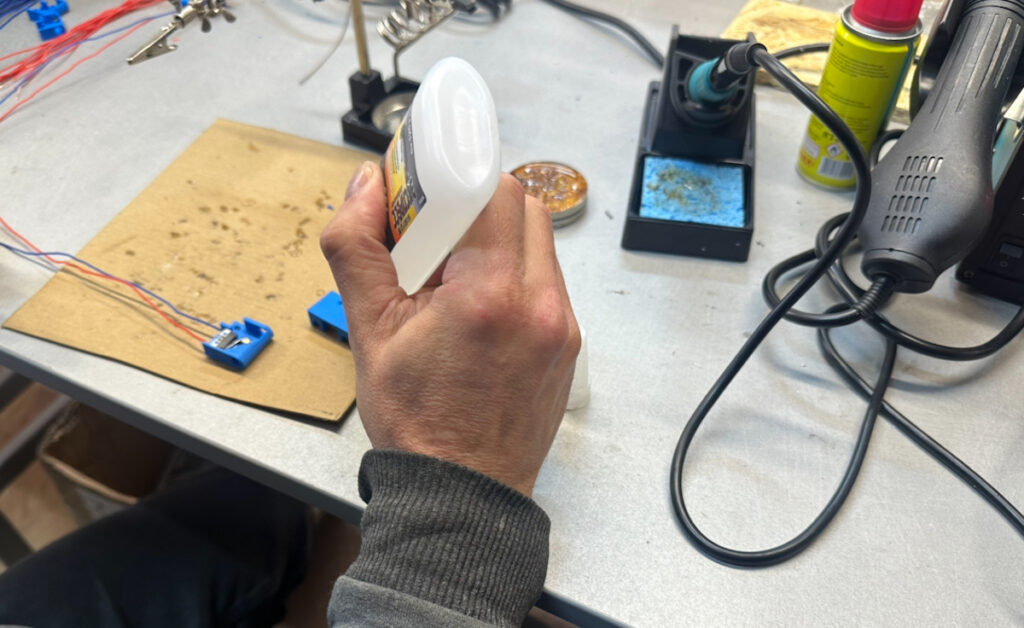What happens when college-age engineers have three years to reinvent warfare? You get a basement situation room that looks like a tech startup but controls weapons that terrify Russian forces. You get workshops where Seattle barista lookalikes turn children’s toys into precision missiles. And you get military innovations that Western armies are now scrambling to understand.
We drive through automatic gates into an open courtyard where autumn flies buzz in the still-warm air. Past a sleek modern façade, quirky sculptures, and multi-layered terraces, this looks like any Silicon Valley startup. Except this compound sits near Ukraine’s frontline, where young engineers have three years to solve a problem every military faces: how do you win when the enemy has more of everything?
In an undisclosed location near Ukraine’s frontline, young Ukrainians are solving problems that military academies worldwide are still trying to comprehend. Their solutions are already changing how wars are fought—and every military planner from Washington to Beijing is taking notes.
When war meets tech startup aesthetics
The control room basement looks like a mix of a home cinema and a White House situation room. Three men and a woman in trendy t-shirts sit at computers facing giant TV screens. Live drone footage streams across displays framed by close-ups, text comments, and maps. Small x-marks appear, followed by puffs of white smoke spreading on screen. This isn’t a video game—real drones are hitting real targets.
“The second one has been kicked out by the EW,” says an operator, eyes glued to his screen. Everyone wears earphones—unclear whether they’re coordinating with each other, pilots kilometers away, or both. Electronic warfare plays out invisibly above every mission.
“These are coordinators providing information to pilots working in dugouts,” explains the commander, an athletic man in his 40s. “Drones can fly up to 20 km with retranslators attached.” The technology sounds simple. The coordination represents warfare’s future.
A blonde woman with a ponytail speaks urgently: “Watch out! On your left!” She’s guiding someone she’s never met through a mission that could save Ukrainian lives or eliminate Russian equipment worth millions.
Detailed maps cover other walls. A glass coffee table displays a moving map on its surface. The environment screams high-tech minimalism, except for sticky tape dangling from the ceiling—black with dead flies, tiny legs and wings spread like miniature antennae.
Near the exit, a large drone resembles a cosmic barrel.
“A Vampire,” the commander says. “Russians call it Baba Yaga.”
Russians nicknamed this Ukrainian drone after a folklore witch because it haunts their troops at night—too heavy and loud for daylight operations. Beyond its intimidating engine and broomstick design, the real threat comes from thermal imaging and anti-tank mine payloads. Bypassing Russian electronic warfare, Baba Yaga autonomously finds targets, drops up to four shells per flight, and returns home. Each mission eliminates multiple Russian positions.
Where children’s toys become weapons

The workshop reveals the secret behind Ukraine’s drone advantage: rapid adaptation.
Ten young men with hipster beards work in cubicles, melting and welding metallic parts and motherboards. Wires and bright blue Lego-like components pile on white desks. Shelves display FPV drones with black propellers jutting out. This tech incubator produces 60-70 combat-ready drones daily.
The supervisor, call name Diver, looks like a Seattle barista and grins constantly.
“We change kids’ toys into weapons,” he says matter-of-factly. “Government supplies standard commercial drones. Not useful as-is. We adapt them—attach retranslators so they fly further, change frequencies to avoid enemy electronic warfare. We fly at non-standard frequencies, say 700.”
Every innovation sparks countermeasures, demanding counter-countermeasures.
Three 3-D printers churn constantly in the corner, manufacturing custom parts. The base technology comes from DJI, China’s drone giant, but the weaponization happens here, in a workshop that operates under strict operational security.

Diver claims not to know how drones reach the workshop—possibly stretching facts, but operational security matters most. Russian missiles would target this facility within hours of discovery.
Life in drone territory requires new rules: no daytime driving, special vehicle coverings at night, drivers wearing night-vision goggles instead of headlights. Enemy reconnaissance drones hunt constantly.
David vs. Goliath: Innovation vs. mass production
Drone warfare boils down to one principle: innovate faster than your adversary. Ukraine faces the classic startup challenge—superior innovation versus superior resources.
“Russia has a DJI factory, giving them volume advantage,” Diver explains. “We lead in innovation but can’t match production. We’d love technology exchange with the West—show them our combat-tested inventions while getting AI solutions, camera stabilizers, night-vision goggles.”
“We access existing technologies and cooperate with national labs,” the commander adds. “But sometimes we reinvent wheels, wasting time on technologies the West already developed.”
The human cost is real, he emphasizes. “During that time, we lose people. We can’t afford it. We’re pushing flight distance to 40 km to hit Russian artillery.”
“Ultimately, we want to fly these to Moscow,” Diver laughs.
The economics of precision killing

The second floor houses testing. A slender woman with dark hair leads software development—she resembles Trinity from The Matrix and laughs when the commander jokes she could hack anything—the Kremlin, possibly.
Four laid-back young men test drones, attaching loads and ensuring flight capability. High ceilings allow indoor test flights—each calibration could determine mission success.
“These are kamikaze drones—FPV drones carrying explosives and blowing up on impact,” Diver explains. “More precise than ‘drops’ from Mavic drones. Kamikaze is way more cost-efficient. They cost $300-400 versus $3,000 for artillery strikes. FPV has become standard ammunition.” The math is brutal: cheaper weapons winning against expensive ones.

Hi, I’m Zarina, a frontline reporter for Euromaidan Press and the author of this piece. We aim to shed light on some of the world’s most important yet underreported stories. Help us make more articles like this by becoming a Euromaidan Press patron.
“Business management helps in modern warfare,” the commander notes. “This production costs 30 million hryvnias monthly [$720.3k] for materials—spare parts, 3D printer filament, excluding ammunition,” says the commander. “We need more production machinery to make things locally.”
When old meets new in war
Technology isn’t the only battlefield. Training pilots reveals deeper challenges every military faces: adapting old hierarchies to new realities.
“I strongly believe that training needs to be done close to the frontline,” the commander insists. “Not in Kyiv or Odesa. We retrain pilots after those rear schools teach outdated methods.”
Another officer arrives with fighters for technical retraining.
“Drone warfare is new. It is not included in the classic textbooks,” he says. “There’s always clash between new and old. Old-school commanders stick to Soviet rules. It doesn’t work.”
This institutional resistance isn’t uniquely Ukrainian—militaries worldwide struggle with similar transitions.
Sometimes qualified drone operators get sent to dig trenches—misallocation that costs lives.
“The frontline is redefined. This isn’t WWI. I just ordered a ground drone—basically a remote-control car. It evacuates wounded, delivers supplies, does mining and demining. We need people for sophisticated tasks and must save lives.”
“Our soldiers train in the UK and report mental gaps upon return. Our tactics are landscape-specific—desert methods don’t work in forests.”
He sees opportunity for knowledge exchange.
“We should send our instructors abroad—Western militaries would benefit from our hands-on experience. We’re developing drone warfare export potential. These evacuation drones could revolutionize urban warfare.”
But the human cost weighs on him.
“Our people need breaks to recharge without combat stress. Mental burnout is real—it’s about rest, not just skills.”
Your military is studying this
Ukraine’s drone workshops aren’t just about survival—they’re laboratories where warfare’s future gets written in real time. Young engineers transform commercial toys into precision weapons while adapting to Russian countermeasures under constant missile threat.
While Ukrainian ingenuity leads innovation, production scale remains the challenge. Western collaboration could bridge this gap decisively.
Every defense contractor is analyzing these cost equations. Every military academy is rewriting textbooks based on lessons from workshops that look like startups but operate under existential threat. Ukraine isn’t just defending territory—it’s pioneering methods that will define the next decade of global conflicts.

Technology is Ukraine’s chance to win the war. This is why we’re launching the David vs. Goliath defense blog to support Ukrainian engineers who are creating innovative battlefield solutions and are inviting you to join us on the journey.
Our platform will showcase the Ukrainian defense tech underdogs who are Ukraine’s hope to win in the war against Russia, giving them the much-needed visibility to connect them with crucial expertise, funding, and international support. Together, we can give David the best fighting chance he has.
Join us in building this platform—become a Euromaidan Press Patron. As little as $5 monthly will boost strategic innovations that could succeed where traditional approaches have failed.



